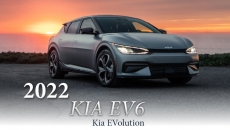After a successful, ground-breaking run with the first-generation Mirai, Toyota is doubling down on a hydrogen-powered future and is introducing an all-new model. This time built on the same global GA-L rear-wheel drive underpinnings shared by the Lexus LC and LS, the environmentally-friendly four door is totally reimagined.
“The Toyota Mirai changes everything about personal mobility – offering drivers an advanced powertrain that produces zero emissions and is as fast as gas to refuel,” says Toyota Canada VP Cyril Dimitris in a media release. “But above all, the new Toyota Mirai is a vehicle that drivers will choose because it’s a gorgeous sedan that’s fun to drive – and that just happens to be a fuel cell electric.”

Appearing much longer and more luxurious than before due to the platform change, the front fascia retains a sleek, slightly futuristic aesthetic now wearing longer bi-beam LED headlights designed to animate in a sweeping motion at start-up. Directly below are matching horizontal signature daytime running lights flanking a massive contrasting and horizontally-slatted black Camry-esque grille and silver-coloured lower lip.
Retaining coupe-like styling with a fastback roof, the light bar running across the trunk returns although the previously chunky lower taillamps have been integrated neatly on the ends. Standard 19-inch or optional 20-inch alloy wheels completely the premium-looking package.

Given the car’s Lexus DNA, an upscale interior is expected and delivered, especially on the top Limited trim we tried out. The man-made perforated SofTex leather upholstery is supple and is complemented by copper coloured door and centre console trim. Overhead an expansive panoramic moon roof lets in natural light, and the surrounding headliner incorporates some neat technology. The top side has a reflective layer to block infrared light reducing heat build-up in the cabin, in turn easing the load on the air conditioning system helping conserve energy.
Infotainment is an area Toyota has traditionally fallen behind on compared to competitors in the marketplace, and the unit here is not the most intuitive either. For example, while the physical heated seat controls are located on the dash, the heated steering wheel toggle is inexplicably digital and buried in the submenus. The Premium JBL Audio stereo does sound good, though.

Powering the vehicle is a second-gen fuel cell system converting stored hydrogen into electricity, feeding a single motor sending 182 horsepower and 221 lb-ft of torque to the back wheels. Real-world range on a full tank is around 600 kilometres. Though certainly not fast, the quick acceleration makes you forget about it and in many ways, the response feels similar to a traditional internal combustion automobile rather than a high-strung EV. And the only “emissions” created? Pure water, expelled out of a spigot mounted underneath the car.
Factor in the aforementioned rear-wheel layout, plus near 50:50 weight distribution, and the sedan really provides quite a pleasant experience behind the wheel — and may even cause a little bit of a tail slide around corners in the rain.
Of course, infrastructure remains a challenge — there are all of three stations in the Lower Mainland (located in Vancouver, Burnaby and North Van), with one on the island. If this chicken and the egg scenario resolves itself however, Toyota is really proving battery electric propulsion might not be the only answer.
Highlights (as tested)
MSRP: $79,825
Motor: single
Horsepower: 182
Torque (lb-ft): 221
Transmission: one-speed direct-drive
Layout: front motor, rear-wheel drive
Fuel economy: 3.2 Le/100 km mixed city/highway (manufacturer estimate)







